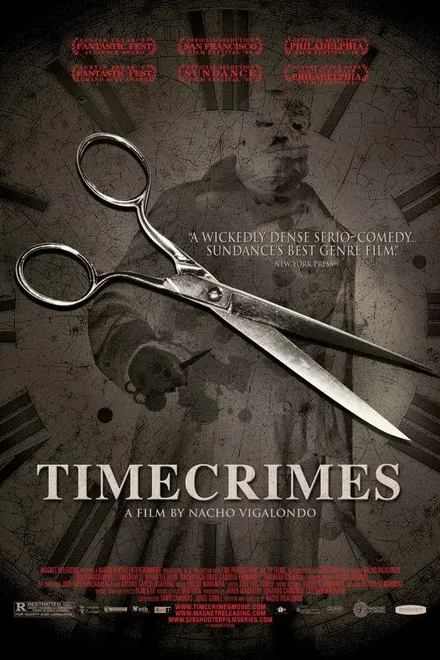
Directed by: Nacho Vigalondo
Starring: Karra Elejalde, Candela Fernández, Bárbara Goenaga, Nacho Vigalondo
⏳ Introduction: Entering the Loop
Timecrimes (2007), directed by Nacho Vigalondo, is a tightly constructed Spanish sci-fi thriller that explores the darkest implications of time travel. When ordinary man Héctor stumbles into a laboratory and unwittingly becomes his own antagonist, a simple day unspools into a nightmare of paradoxes, violence, and unraveling identity. The film’s brilliance lies in its relentless logic—every twist is the inevitable result of a previous action, and every attempt to “fix” the past only deepens the spiral of confusion.
🚨 The Butterfly Effect: Small Choices, Big Consequences
What begins as a moment of curiosity—a glimpse of a mysterious figure in the woods—quickly escalates. Héctor’s pursuit of the unknown draws him into a time machine, sending him an hour into the past. To avoid encountering himself, Héctor dons a bandaged disguise and becomes the very threat he was fleeing. The film loops through the same events multiple times, each iteration revealing new details and amplifying the tension.
Vigalondo’s script is ruthlessly efficient: every prop, location, and character is used and reused in service of the film’s paradoxes. Time, in Timecrimes, is not a linear path but a Möbius strip, twisting back on itself and binding Héctor ever tighter to his fate.
🧩 The Puzzle of Identity and Self-Deception
As the timeline knots ever tighter, Héctor’s sense of self begins to fracture. He is simultaneously victim and perpetrator, witness and architect of his own misery. The film probes the horror of self-knowledge: what if you could see every mistake you’ve made, and were powerless to stop yourself from repeating them?
The bandaged “villain,” at first a terrifying presence, is revealed to be another version of Héctor, driven by fear and desperation. The layers of doubling, mirroring, and role-reversal create a puzzle-box narrative in which identity is always unstable and contingent.
🪞 Fate, Free Will, and the Limits of Control
Timecrimes refuses to offer easy answers about the possibility of escape. Each attempt to change the timeline only reinforces its closed structure, suggesting that free will is an illusion and fate is inescapable. Héctor’s journey becomes a meditation on regret, accountability, and the limits of knowledge. The film’s final act, in which Héctor must choose whether to allow a tragedy to occur in order to preserve the timeline, is as morally wrenching as it is logically precise.
🎯 Final Thoughts: The Paradox That Remains
Timecrimes is a model of twist-driven storytelling, using time loops not as mere gimmick but as a lens for exploring the contradictions of identity and consequence. Its haunting conclusion suggests that the true crime is not what we do to others, but what we do to ourselves when we try to outrun our own past.